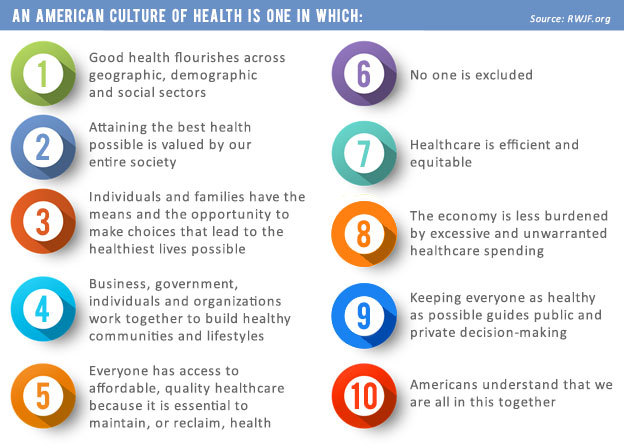Communities and companies alike are on a mission to create a culture of health. Obesity, chronic disease and diabetes management have long been a wellness focus for employers. 25 years ago, the Americans with Disabilities Act was passed and its intent, along with other programs designed to help employees with disabilities, illnesses or injuries, was to create a more engaged workforce through better work solutions and accommodations. Resulting programs have had questionable impact on production and return on investment. Now, health reform is creating a need for employees and patients to become health consumers. The intersection of these programs, and others similar, along with the desire to maintain an engaged workforce, are fueling a desire and business need to create a culture of health within the workplace.
A culture of health can foster both mental and physical well-being and corresponding healthy decisions throughout an organization. It has long been documented that a healthy corporate culture leads to employee retention and satisfiaction, and quality products. A culture of health supports a healthy culture by shifting the focus to health of employees, business units and the company. Today’s organizations have a diverse population of employees with widely varying levels of health needs. A culture of health is designed to encourage and foster each individual leading a healthier life.

From a community or population health perspective, the Robert Wood Johnson Foundation (RWJF) is leading efforts to make a culture of health a national priority. The health of our nation will not improve based solely on employer solutions and I applaud the RWJF and their efforts and reach. I encourage you to check out rwjf.org to learn more about their culture of health community initiatives. RWJF acknowledges there is no single definition of a culture of health; it is as multifaceted as the population it serves.
As employees become actively engaged in their health, productivity and financial performance improves. NextHealth co-founder, Ray Fabius, MD, is a world-renowned global physician executive and population health expert. In Dr. Fabius’ latest book Population Health, he writes, “When legislators and politicians speak about ‘bending the healthcare cost curve’ those that have built ‘cultures of health and wellness’ have done it.” Employers with successful culture of health programs understand that the culture of a company and the health of its workers impacts all employees from the manufacturing floor to client-facing colleagues, supervisors, leadership and includes the C-suite. A culture of health is one which encourages healthy decisions at work and at home, for the employee and their family.
Some organizations, like Johnson & Johnson, have created a sustainable culture of health that has proven successful and the benefits are well-documented. Check out their website to learn more about the J&J culture of health program.
How does an employer go about creating a culture of health? Buy-in from human resources, risk management, leadership and key stakeholders throughout the organization is a must; make this a company initiative and, equally important, a corporate value. Cultures do not change overnight and evolve over time, so plan accordingly.
Define your benchmarks to assess success and communicate expectations broadly and repeatedly. You may want to consider having health goals as a performance metric or business unit objective. The action plan and strategy to implement and grow the culture of health should be thoughtful and approached in such a way that all colleagues feel included and will participate. Finally, companies should consider and track how their financial performance is impacted post-implementation of a culture of health. Considerations for tracking financial performance may include productivity, absence, health costs, revenue and EBITDA. As documented by HealthNext, companies focused on a culture of health outperform those without a corporate strategic health program.
Risk managers should be as engaged in creating a culture of health as health benefits, wellness, disability and leave of absence managers. The organizational impact to productivity, workers’ compensation and risk portfolios is meaningful.
I encourage you to join the dialogue about population health and creating a culture of health. Follow the conversation with Sedgwick as we explore this topic from the #RIMS2015 conference this week at our annual healthcare breakfast where we will ask the experts, “What’s your methodology for creating a culture of health?”
I look forward to providing insights and ideas gathered from this session through future blog posts and Sedgwick’s new quarterly publication, the edge.
Kimberly George, SVP, Corporate Development, M&A, and Healthcare